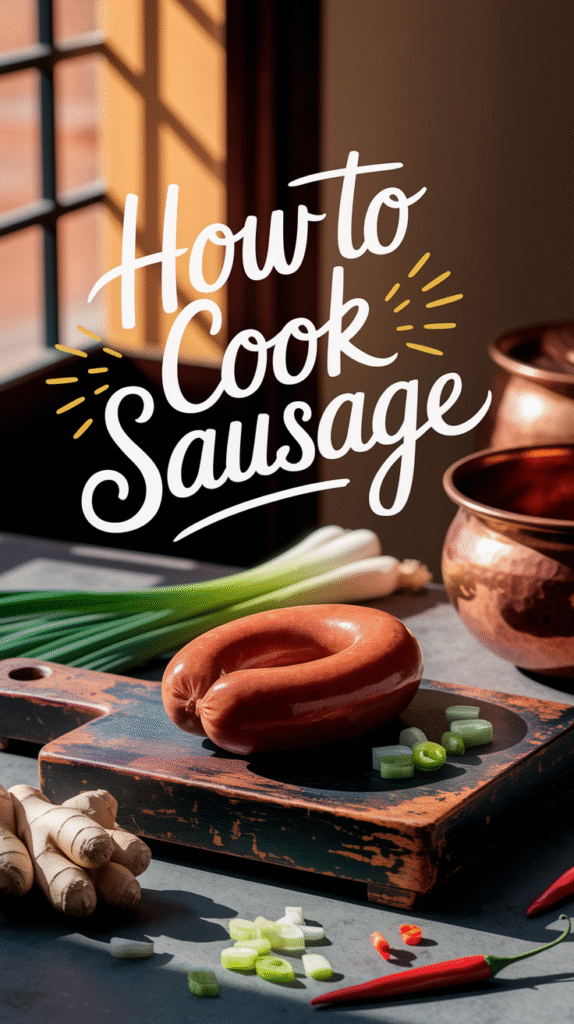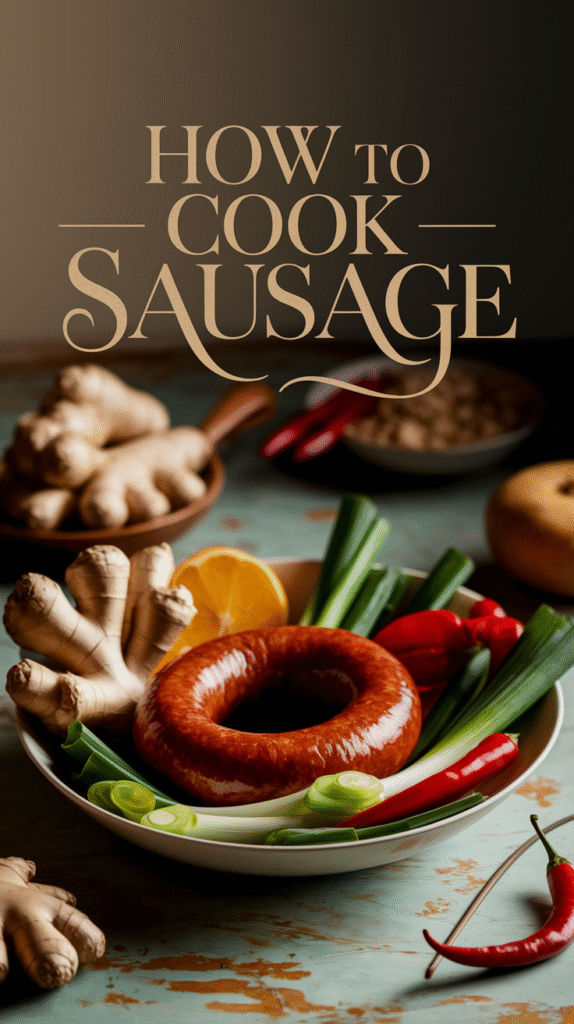Cooking sausage is a delightful way to bring flavor and satisfaction to your meals. Whether you’re prepping for breakfast, lunch, or dinner, knowing how to cook sausage properly can make all the difference. Here, you’ll discover various cooking techniques and tips to ensure that your sausage is juicy, flavorful, and perfectly cooked.
First, let’s explore the types of sausage you may encounter:
- Fresh Sausage: Such as breakfast sausage or Italian sausage, which need to be cooked thoroughly.
- Smoked Sausage: Examples include kielbasa and andouille, which are usually pre-cooked and can be reheated.
- Dry Cured Sausage: Salami and pepperoni can be eaten raw.
To achieve the best results with each type, let’s look at the techniques for cooking sausage.
Pan-Frying
Pan-frying is a favored method that delivers a crispy exterior and tender inside.
- Heat a skillet over medium heat.
- Add a small amount of oil if using lean sausage.
- Place the sausages in the pan, being careful not to overcrowd them.
- Cook for 6-8 minutes on each side, turning them occasionally until golden brown and the internal temperature reaches 160°F (71°C).
Tip: For extra flavor, add herbs, onions, or peppers to the pan while cooking.
Baking
Baking is a great option if you want sausages cooked evenly.
- Preheat your oven to 375°F (190°C).
- Place the sausages on a baking sheet lined with parchment paper.
- Bake for about 25-30 minutes, turning halfway through for even cooking.
Baking allows the grease to drip off, resulting in a healthier dish. This method is particularly useful for larger batches.
Grilling
Grilling sausage brings a unique smoky flavor making it perfect for outdoor cookouts.
- Preheat your grill to medium heat.
- Place sausages over direct heat and cook for about 10-15 minutes.
- Turn occasionally until they are nicely browned and reach an internal temperature of 160°F (71°C).
Tip: Avoid piercing the sausage, as this can cause the flavorful juices to escape.
Boiling and Then Pan-Frying
This two-step approach ensures juicy sausages with a crispy finish.
- Start by boiling the sausage in a pot of water for about 10-15 minutes.
- Drain the sausages and transfer them to a preheated skillet.
- Pan-fry on medium-high heat until browned on each side, about 4-6 minutes.
This method minimizes the risk of undercooking while still providing a nice crispy layer.
Using a Slow Cooker
A slow cooker is a fantastic way to prepare sausages with minimal effort.
- Add sausages to the slow cooker with vegetables, broth, and seasonings.
- Set on low for 6-8 hours or high for 3-4 hours.
The result is tender sausage packed with flavor, perfect for hearty meals.
Essential Tips for Cooking Sausage
- Check the internal temperature: Always ensure your sausage reaches 160°F (71°C) to ensure it’s safe to eat.
- Use natural casings: If possible, choose sausages with natural casings as they enhance flavor and texture.
- Rest your sausages: Let them sit for a few minutes after cooking to lock in juices.
- Try different seasonings: Experiment with spices and marinades for unique flavors.
Whether using a stovetop, oven, grill, or slow cooker, mastering these techniques will enhance your cooking repertoire. More information on cooking sausage can be found at Simply Recipes and Epicurious.
Cooking sausage doesn’t have to be intimidating. With these techniques and tips, you’ll create delicious meals that will impress family and friends every time!
The Best Types of Sausage for Different Dishes
Sausages are a versatile ingredient that can transform a meal into an unforgettable experience. They come in various flavors and types, making it essential to choose the right one for your dish. Below, we explore some of the best types of sausage suited for different culinary creations.
Breakfast Dishes
When it comes to breakfast, the classic breakfast sausage is unbeatable. It’s usually made from pork and flavored with a blend of spices, making it savory and satisfying. Here are some popular choices:
- Pork Sausage Links: These are small, typically sweet or mildly spicy, and perfect for pairing with pancakes or eggs.
- Chicken Sausage: A leaner alternative, chicken sausage provides a lighter option without sacrificing flavor. Look for varieties infused with herbs.
- Turkey Sausage: Ideal for those watching their fat intake, turkey sausage can be seasoned similarly to pork sausage for a tasty breakfast.
Lunch and Sandwiches
For lunch, sausages can make excellent sandwiches or salads. Here are some recommendations that help enhance your midday meals:
- Italian Sausage: This type comes in both sweet and spicy variants, making it perfect for Italian sandwiches. Grill or sauté it, then serve in a crusty bun with marinara sauce.
- Bratwurst: Perfect for grilling, bratwurst has a mild flavor that pairs well with sauerkraut and mustard.
- Chorizo: This spicy sausage hails from Spain and Mexico. It adds a robust flavor to tacos, burritos, or even salads.
Dinner Options
Sausages can elevate your dinner dishes and make them more hearty. Here are some types to consider:
- Andouille Sausage: Commonly used in Cajun cooking, this smoked sausage is a key ingredient in gumbo and jambalaya.
- Farmers Sausage: This is a traditional sausage that can be added to stews or roasted with vegetables for a comforting dinner.
- Sundried Tomato & Basil Chicken Sausage: A flavorful option great for pasta dishes or simply sliced and added to salads.
Slow Cooking and Stews
Some sausages are best when cooked slowly, allowing their flavors to meld into hearty meals. Consider these options:
- kielbasa: This Polish sausage is ideal for slow-cooked dishes like soups and casseroles. Its smoky flavor enhances the overall dish.
- Duck Sausage: Adds a touch of gourmet flair to your stews while bringing rich flavors. Perfect for a special occasion.
Grilling and Barbecues
Summer is a great time for BBQ and grilling, and sausages are the life of the party. Here are the best options for grilling:
- Bratwurst: Perfect for grilling. Just cook them slowly over medium heat until browned and cooked through.
- Argentinian Chorizo: Known for its seasoning, this type of chorizo is great for grilling and serves wonderfully with chimichurri sauce.
Unique Flavor Sausages
If you’re looking to spice things up, consider trying these unique types of sausages:
- Beer Bratwursts: Infused with beer, they offer a distinct taste that’s fantastic on the grill.
- Vegetarian Sausage: For those who prefer a meat-free option, plant-based sausages made with ingredients like tofu or lentils can be flavorful and satisfying.
The right type of sausage into your dishes can bring new flavors and textures to your recipes. With so many varieties available, you can easily find the perfect sausage for any meal. For more insights on sausages, check out Sausage Republic and The Kitchn.
Explore your options and savor the delicious possibilities that sausages can provide in your meal planning!
Safety Tips for Cooking and Storing Sausage
When it comes to cooking sausage, safety is paramount. Whether you’re grilling, pan-frying, or baking, understanding how to handle and store sausage properly ensures both delicious meals and safe eating. Here are a variety of safety tips that will help you enjoy sausage without any worries.
First and foremost, always wash your hands before and after handling sausage. Raw meat can carry bacteria, so keeping your hands clean prevents cross-contamination. Use warm water and soap, scrubbing for at least 20 seconds. Additionally, keep all surfaces and utensils clean. This includes countertops, cutting boards, and knives. Using separate boards for raw meats and other foods is an excellent way to avoid mixing flavors and preventing foodborne illnesses.
When you cook sausage, it’s essential to reach the right internal temperature. For pork, beef, and lamb sausages, the USDA recommends an internal temperature of 160°F (71°C) and for poultry sausage, aim for 165°F (74°C). The best way to check this is with a reliable meat thermometer. Insert the thermometer into the thickest part of the sausage without touching the pan. When the safe temperature is reached, it’s not only safe to eat but also offers the best flavor and texture.
Another crucial aspect is proper cooking techniques. Here are some methods:
- Grilling: Preheat your grill to medium heat. Place the sausages on the grill, turning occasionally, until they have grill marks and reach the proper temperature.
- Pan-frying: Heat a little oil in a skillet over medium heat. Add the sausages and cook for 12-15 minutes, turning occasionally, until browned and fully cooked.
- Baking: Preheat your oven to 400°F (200°C). Place sausages on a baking sheet and bake for 20-25 minutes, turning halfway through.
Storing sausage correctly is just as important as cooking it. If you have leftover cooked sausage, it should be stored in the refrigerator within two hours of cooking. Use airtight containers to keep it fresh and ensure it’s consumed within 3-4 days. If you won’t eat it within that time frame, consider freezing it.
| Storage Type | Duration |
|---|---|
| Refrigerator | 3-4 days (cooked) |
| Freezer (cooked) | 2-3 months |
| Refrigerator (raw) | 1-2 days |
| Freezer (raw) | 1-2 months |
When thawing frozen sausage, it’s best to do so in the refrigerator. This method ensures it stays out of the danger zone where bacteria can grow. If you’re in a hurry, using the microwave or submerging it in cold water can work, but make sure to cook it immediately after thawing.
Additionally, be mindful of food allergies and sensitivities. Some people may have reactions to certain spices or fillers in sausage. Always check labels if you’re buying pre-packaged sausage. This diligence can save you from unforeseen health issues.
Remember to always check expiration dates on packaged sausage. If the sausage looks discolored or has an off odor, don’t take the risk. Discard it right away. Safety should always be your first priority when cooking and storing sausage.
If you’re looking for more in-depth information, you can visit [FoodSafety.gov](https://www.foodsafety.gov/) for the latest guidelines on proper cooking and storing practices. Ensuring safety while cooking sausage not only elevates your culinary experience but also contributes significantly to your health and well-being.
By following these safety tips, you can enjoy delicious sausage dishes while keeping foodborne illnesses at bay. Happy cooking!
Delicious Sausage Recipes for Every Meal
Sausages are not only versatile but also packed with flavor, making them a fantastic option for any meal of the day. Whether you’re preparing breakfast, lunch, or dinner, there’s a delicious sausage recipe waiting for you. Here are some mouth-watering ideas that will surely excite your taste buds.
Breakfast Sausage Recipes
Start your day off right with these hearty breakfast sausage recipes. They’re easy to make and full of energy-boosting ingredients.
- Classic Breakfast Burrito
Ingredients:- Breakfast sausage
- Scrambled eggs
- Shredded cheese
- Flour tortillas
- Chopped vegetables
Instructions: Cook the sausage, scramble the eggs, and then wrap everything in a tortilla. Top with cheese and salsa for an added kick.
- Savory Sausage and Gravy
Ingredients:- Ground sausage
- Flour
- Milk
- Biscuits
Instructions: Cook ground sausage in a pan, then stir in flour and gradually add milk until thickened. Serve over warm biscuits.
Lunch Sausage Delights
These lunch recipes with sausage will keep you satisfied and energized throughout the afternoon.
- Sausage and Pepper Sandwich
Ingredients:- Italian sausage
- Bell peppers
- Onions
- Sub rolls
Instructions: Grill or sauté sausage until cooked through. Add peppers and onions and cook until soft. Serve in a toasted sub roll.
- Sausage Pasta
Ingredients:- Ground sausage
- Pasta of choice
- Tomato sauce
- Parmesan cheese
Instructions: Brown the sausage, add cooked pasta, and finish with tomato sauce and parmesan cheese. Simmer for a few minutes before serving.
Dinner with Sausage
Wrap up your day with satisfying dinner recipes, showcasing the rich flavors of sausage.
- Sausage and Vegetable Skewers
Ingredients:- Sausage links
- Zucchini
- Cherry tomatoes
- Bell peppers
- Olive oil
Instructions: Cut sausage and vegetables into chunks, marinate with olive oil, then skewer and grill until cooked.
- Sausage Stuffed Peppers
Ingredients:- Bell peppers
- Ground sausage
- Rice
- Cheese
Instructions: Mix cooked rice with ground sausage and stuff into halved peppers. Top with cheese and bake until the peppers are tender.
Quick and Easy Snacks
For a quick bite, these recipes are perfect for snacking or serving at gatherings.
- Sausage Rolls
Ingredients:- Puff pastry
- Sausage meat
- Egg wash
Instructions: Wrap sausage meat in puff pastry, brush with egg wash, and bake until golden brown.
- Sausage Quesadillas
Ingredients:- Cooked sausage
- Cheese
- Tortillas
Instructions: Assemble sausage and cheese between two tortillas, grill until crispy, and slice into wedges.
These scrumptious sausage recipes offer a variety of flavors and cooking methods, ensuring there’s something for everyone. For more information on sausage cooking techniques and recipes, you can check out Sausage Source or get inspired by delicious ideas at Food Network.
With these simple and tasty options, you can make sausage the star of your meals at any time of the day! Enjoy experimenting in the kitchen with these delightful recipes and discover just how versatile and satisfying sausages can be.
Exploring Global Sausage Varieties and Cooking Methods
When it comes to sausages, the world is full of diverse and enticing varieties, each with unique flavors and cooking methods that reflect the culinary heritage of their region. This delightful meat product is not only an essential ingredient in various cuisines but also a delicious expression of cultural traditions.
Across continents, you’ll encounter a plethora of sausage types, each bringing something special to the table. Whether grilled, boiled, or smoked, the love of sausages unites food enthusiasts globally. Here’s a look at some notable sausage varieties and how to cook them.
Popular Global Sausage Varieties
Each country boasts its specialties, often using locally available ingredients. Below are some of the most popular types of sausages found worldwide:
- Bratwurst – Originating from Germany, bratwurst is made primarily from pork and is often flavored with spices such as ginger, nutmeg, and cardamom.
- Chorizo – A spicy Mexican sausage, chorizo is typically made from pork, seasoned with chili powder, and smoked paprika.
- Saucisse de Toulouse – A French sausage known for its flavor, it consists of pork, salt, and several herbs and spices.
- Andouille – This smoked sausage hails from France and is a staple in Cajun cooking. It is usually made with pork and has a robust flavor.
- Lap Cheong – A sweet and savory Chinese sausage that is often used in rice dishes and stir-fries, made primarily from pork and flavored with sugar, soy sauce, and rice wine.
Cooking Methods for Sausages
Once you’ve selected your sausage, the next step is to cook it. Different methods can enhance the flavors of various sausage varieties. Here are some common cooking techniques that work well:
Grilling
Grilling is one of the most popular ways to cook sausages, offering a smoky flavor and juicy texture. Preheat your grill to medium heat. Place the sausages directly on the grill grates. Cook them for about 10-15 minutes, turning them occasionally until they reach an internal temperature of 160°F (71°C).
Boiling
Boiling is a straightforward cooking method that retains moisture in the sausages. To do this, place the sausages in a pot and cover them with water. Bring the water to a simmer and cook the sausages for around 20 minutes. After boiling, you can finish them off on the grill or skillet for added crispiness.
Baking
Baking sausages in the oven is another excellent cooking technique. Preheat your oven to 375°F (190°C) and place the sausages on a baking tray lined with parchment paper. Bake for about 25-30 minutes or until the internal temperature reads 160°F (71°C), turning them halfway through for even cooking.
Frying
Frying sausages allows for a crispy exterior. Heat a pan over medium heat and add a little oil. Place the sausages in the pan and cook for about 10-15 minutes, turning occasionally until they’re browned and cooked through.
Regional Cooking Secrets
| Region | Sausage Type | Cooking Secret |
|---|---|---|
| Germany | Bratwurst | Allow to simmer in beer before grilling. |
| Spain | Chorizo | Cook in olive oil with garlic for depth of flavor. |
| USA | Andouille | Use in a gumbo for authentic Cajun taste. |
| China | Lap Cheong | Steam before slicing to enhance sweetness. |
As you explore the world of sausages, you’ll find that experimenting with different cooking methods can lead to delightful culinary discoveries. For deeper insights into sausage-making techniques and recipes from various cultures, check out resources like Serious Eats or Food & Wine.
By appreciating the diverse sausage offerings globally and mastering cooking techniques, you’ll elevate your next meal. Enjoy these traditional flavors as you embark on your culinary journey through the world of sausages!
Conclusion
Cooking sausage is both an art and a science, and mastering the techniques covered can greatly enhance your culinary skills. By understanding the best types of sausage for various dishes, you can elevate your meals, whether you’re grilling for a barbecue, adding flavor to pasta, or whipping up a hearty breakfast. Safety is paramount when handling and storing sausage; always follow safe cooking guidelines to enjoy your dishes without concern.
The diverse world of sausages, from spicy chorizo to savory bratwurst, offers unique flavors and textures that can adapt to any cuisine. global sausage varieties into your cooking not only broadens your palate but also encourages exciting culinary experiments in the kitchen.
With a plethora of delicious sausage recipes at your fingertips, you’ll discover that sausage is incredibly versatile. From classic comfort foods to innovative dishes, there’s a sausage recipe to suit every occasion and taste. Embrace the variety and enjoy the delightful experience of cooking sausage, turning ordinary meals into extraordinary feasts.
As you explore sausages and their diverse cooking methods, remember that practice and creativity will make you a more confident cook. Don’t hesitate to experiment with different spices, herbs, and cooking techniques. With every new dish, you’ll find your own favorite ways to prepare sausage, making mealtime a celebration of flavors and traditions. Happy cooking!







Leave a Reply